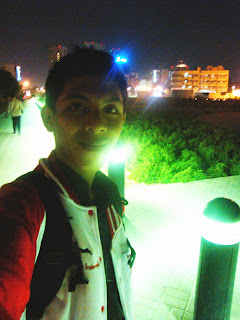Perubahan iklim merupakan masalah krusial yang tengah dihadapi masyarakat dan harus segera ditanggulangi. Meskipun tidak mungkin dihentikan, perubahan iklim ini masih dapat diperlambat dengan berbagai cara. Berbagai pihak telah mengupayakan hal tersebut, tidak terkecuali Dewan Nasional Perubahan Iklim (DNPI) yang merupakan bagian dari Kementrian Lingkungan Hidup Republik Indonesia dengan menyelenggarakan acara annual "Youth for Climate Camp" atau YFCC.
Dalam acara edukatif lingkungan ini, FBS diwakilkan oleh Sapta Abimanyu, mahasiswa Pendidikan Bahasa Inggris 2011. Esainya yang berjudul "Baduy's Culture: A Solution for Environmental Problems" mengangkat budaya suku Baduy yang sangat menjaga keseimbangan alam. "Essay saya ini sebenarnya adalah tugas kuliah saya yang telah lalu. Saya senang mendapatkan kesempatan untuk berbagi dan mendiskusikan essay saya dalam forum ini," tandasnya.
Kegiatan yang diselenggarakan di Taman Wiladatika Cibubur ini sengaja menyasar generasi muda, karena merekalah agen perubahan yang memiliki andil besar dalam penanggulangan perubahan iklim di masa mendatang. Mereka pulalah yang pasti akan merasakan dampak permasalahan ini sehingga perlu diberikan bekal kepada mereka terkait dengan penanggulangan perubahan iklim.
Abimanyu bersama 125 peserta lain dari berbagai universitas di Indonesia berkesempatan untuk berdiskusi dengan mantan Menteri Lingkungan Hidup Indonesia, Prof. Dr. Rachmat Witoelar, yang menjadi pembicara utama sekaligus penasehat dalam YFCC 2013 ini.
Beberapa pembicara lain yang hadir di antaranya Muhammad Bijaksana Junerosano (CEO Greeneration Indonesia), Gracia Paramitha (UNEP-TUNZA Youth Advisory Council on Asia Pacific Region), dan Untung Widyanto (Wartawan Tempo). Selain itu, sebagai bentuk dukungan kepada kegiatan peduli lingkungan ini, hadir pula perwakilan JICA (Japan International Cooperation Agency) di Indonesia, Jun Ichihara.
"Saya sangat senang bisa mewakili FBS dalam acara tersebut. Banyak ilmu dan pengalaman yang dapat diimplementasikan dalam kehidupan untuk menjaga kestabilan lingkungan, agar iklim tetap bersahabat dengan manusia," ujar Abimanyu yang juga merupakan pengurus Koalisi Pemuda Hijau Indonesia (KOPHI). Kecintaannya terhadap lingkungan terus mendorongnya untuk melakukan berbagai aksi nyata terkait penanggulangan perubahan iklim. Latar belakang pendidikannya yang tidak memiliki kaitan erat dengan lingkungan justru memotivasinya untuk terus mengampanyekan gaya hidup ramah lingkungan.
Bagi Abimanyu, semua pihak mengemban tanggung jawab akan keseimbangan lingkungan. "Saya ingin merintis dan membangkitkan kelompok pemerhati lingkungan yang ada di UNY. Sayang sekali mereka tidak dapat berkembang karena kurangnya perhatian dan sumber daya yang berpengalaman."
Saat ini Abimanyu tengah giat mengajak mahasiswa, baik FBS, UNY, maupun seluruh mahasiswa di Yogyakarta untuk ikut serta dalam aksi "Kali Code Bersih". Salut untuk Abi! (Zakiyah K)
Saat ini Abimanyu tengah giat mengajak mahasiswa, baik FBS, UNY, maupun seluruh mahasiswa di Yogyakarta untuk ikut serta dalam aksi "Kali Code Bersih". Salut untuk Abi! (Zakiyah K)
sumber : http://uny.ac.id/berita/abimanyu-wakili-fbs-dalam-youth-climate-change-2013.html














- Follow Us on Twitter!
- "Join Us on Facebook!
- RSS
Contact